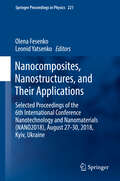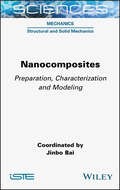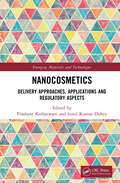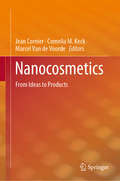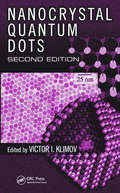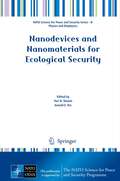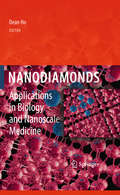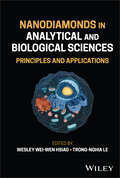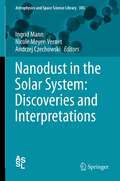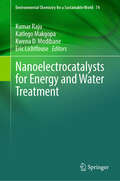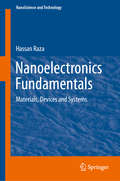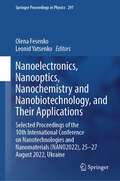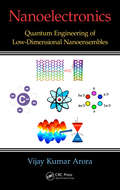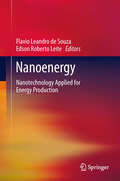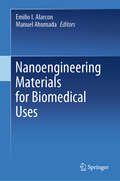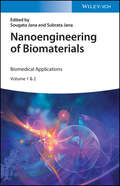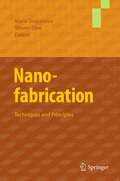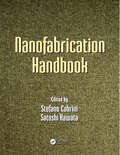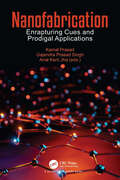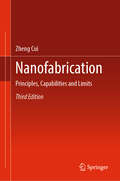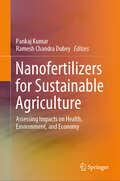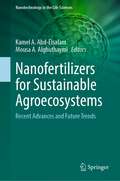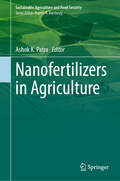- Table View
- List View
Nanocomposites, Nanostructures, and Their Applications: Selected Proceedings of the 6th International Conference Nanotechnology and Nanomaterials (NANO2018), August 27-30, 2018, Kyiv, Ukraine (Springer Proceedings in Physics #221)
by Leonid Yatsenko Olena FesenkoThis book highlights some of the latest advances in nanotechnology and nanomaterials from leading researchers in Ukraine, Europe, and beyond. It features contributions from participants in the 6th International Science and Practice Conference Nanotechnology and Nanomaterials (NANO2018) in Kiev, Ukraine on August 27-30, 2018 organized by the Institute of Physics of the National Academy of Sciences of Ukraine, University of Tartu (Estonia), University of Turin (Italy), and Pierre and Marie Curie University (France). Internationally recognized experts from a wide range of universities and research institutions share their knowledge and key results on material properties, behavior, and synthesis. This book's companion volume also addresses topics such as nanooptics, energy storage, and biomedical applications.
Nanocomposites: Preparation, Characterization and Modeling
by Jinbo BaiNanocomposites are one of the major advances in the field of materials. They have applications in sectors as varied as aeronautics, energy and the environment. However, the effective use of nanocomposites requires new knowledge and tools in order to overcome the difficulties and benefit from the advantages. Nanocomposites presents recent academic and industrial progress in this field, as well as the latest research on the effective use of nanoscale fillers and reinforcements to improve the performance of advanced nanocomposites. It also describes the techniques and tools used to prepare nanocomposites, including the latest techniques for synthesis and surface treatment of nanofillers for different applications. Finally, it details the role of nanoscience in the design, characterization and multi-scale modeling of these materials, with a focus on nanoscale phenomena.
Nanocosmetics Delivery Approaches, Applications and Regulatory Aspects: Delivery Approaches, Applications And Regulatory Aspects (Emerging Materials and Technologies)
by Prashant Kesharwani Sunil Kumar DubeyThis book offers an overview of the science of cosmetics and the formulation of nanosized cosmetic products including fabrication, characterization of nanocosmetics, major challenges in the safe applications, regulatory aspects, and commercialization on a large scale. The chapters provide understanding of the interaction of nanocarriers with skin and hair, different nanocosmetic products in the present situation, applications as well as disadvantageous toxicity associated with nanocosmetics, regulatory prospects, and future perspectives. Features: Provide an explicit account on vital aspects of various nanocosmetics drug delivery approaches, thereby providing a next-generation cosmetic product. Bring together the novel applications of nanocosmetics approaches in the biological milieu. Explores preparation, applications, toxicity, and regulatory prospects. Includes a dedicated chapter on Niosomal drug-delivery systems in cosmetics. Discusses the perspectives of the technologies explored so far based upon the findings outlined in highly organized tables, illustrative figures, and flow charts. This book is aimed at researchers and professionals in nanomedicine, pharmaceuticals, biotechnology, and the health sector.
Nanocosmetics: From Ideas to Products
by Marcel Van de Voorde Jean Cornier Cornelia M. KeckThis book addresses the application of nanotechnology to cosmetics. Edited by three respected experts in the field, the book begins with a general overview of the science behind cosmetics and skin care today, and of the status quo of nanotechnology in cosmetics. Subsequent chapters provide detailed information on the different nanoparticles currently used in cosmetics; the production and characterization of nanoparticles and nanocosmetics; and regulatory, safety and commercialization aspects. Given its scope, the book offers an indispensable guide for scientists in academia and industry, technicians and students, as well as a useful resource for decision-makers in the field and consumer organizations.Chapter 6 of this book is available open access under a CC BY 4.0 licence at link.springer.com.
Nanocrystal Quantum Dots
by Victor I. KlimovA review of recent advancements in colloidal nanocrystals and quantum-confined nanostructures, Nanocrystal Quantum Dots is the second edition of Semiconductor and Metal Nanocrystals: Synthesis and Electronic and Optical Properties, originally published in 2003. This new title reflects the book’s altered focus on semiconductor nanocrystals. Gathering contributions from leading researchers, this book contains new chapters on carrier multiplication (generation of multiexcitons by single photons), doping of semiconductor nanocrystals, and applications of nanocrystals in biology. Other updates include: New insights regarding the underlying mechanisms supporting colloidal nanocrystal growth A revised general overview of multiexciton phenomena, including spectral and dynamical signatures of multiexcitons in transient absorption and photoluminescence Analysis of nanocrystal-specific features of multiexciton recombination A review of the status of new field of carrier multiplication Expanded coverage of theory, covering the regime of high-charge densities New results on quantum dots of lead chalcogenides, with a focus studies of carrier multiplication and the latest results regarding Schottky junction solar cells Presents useful examples to illustrate applications of nanocrystals in biological labeling, imaging, and diagnostics The book also includes a review of recent progress made in biological applications of colloidal nanocrystals, as well as a comparative analysis of the advantages and limitations of techniques for preparing biocompatible quantum dots. The authors summarize the latest developments in the synthesis and understanding of magnetically doped semiconductor nanocrystals, and they present a detailed discussion of issues related to the synthesis, magneto-optics, and photoluminescence of doped colloidal nanocrystals as well. A valuable addition to the pantheon of literature in the field of nanoscience, this book presents pioneering research from experts whose work has led to the numerous advances of the past several years.
Nanodevices and Nanomaterials for Ecological Security
by Arnold E. Kiv Yuri N. ShuninThis book is devoted to a wide range of problems concerning applications of nanomaterials and nanodevices as effective solutions to modern ecological problems. Leading experts in nanoscience and nanotechnology present the key theoretical, experimental and implementation issues related to the creation and utilization of novel nanoscale devices to help ensure ecological security. The authors discuss appropriate nanotechnologies for minimizing various types of risk: to human life, technogenic risk, or indeed terrorist threats. Particular emphasis is placed on defining and studying the required materials properties, and - in the field - on nanoscale devices for sensors and monitoring.
Nanodiamonds
by Dean HoNanodiamonds: Applications in Biology and Nanoscale Medicine highlights the translation of nanodiamonds toward clinical relevance and medical applications. Integrating a spectrum of internationally-recognized experts currently developing these technologies, this book fits as a cornerstone of this exciting field. These include contributions from clinician scientists working at the interface of medicine and nanotechnologies which discuss the critical and requisite properties of nanomaterials, in a concise and cohesive manner. Nanodiamonds: Applications in Biology and Nanoscale Medicine provides a multidisciplinary overview of nanodiamonds and there uses for scientific, engineering and clinical audiences alike.
Nanodiamonds in Analytical and Biological Sciences: Principles and Applications
by Wesley Wei-Wen Hsiao Trong-Nghia LeNANODIAMONDS IN ANALYTICAL AND BIOLOGICAL SCIENCES Comprehensive resource highlighting the significance and applications of fluorescent and non-fluorescent nanodiamonds in various domains Nanodiamonds in Analytical and Biological Sciences combines the disciplines of chemistry, physics, materials science, and biology to demonstrate the significance of nanodiamonds, offering precise analysis of the impacts and up-to-date applications of fluorescent and non-fluorescent nanodiamonds, including in COVID-19 and artificial intelligence, with illustrations, case studies, practical examples, and novel perspectives included throughout. Edited by two highly qualified scholars with significant experience in the field, topics covered include: Fundamental properties, synthesis, mechanisms, and functionalization of nanodiamonds, and toxicity assessment Fabrication and surface modification of fluorescent nanodiamonds and in vitro and in vivo bioimaging of fluorescent nanodiamonds Nanodiamond-enabled drug delivery and nanodiamond for mass spectrometry-based analysis of peptides, proteins, and proteomes Quantum sensing, applications in physico-chemical and biomedical sensing, and perspective and outlook on the future of nanodiamond research Nano-scale thermometry of fluorescent nanodiamonds and nanodiamond-enabled drug delivery Offering a balanced, multidisciplinary, and comprehensive overview of the significance of fluorescent and non-fluorescent nanodiamonds, Nanodiamonds in Analytical and Biological Sciences is an essential resource for academic researchers and industry professionals working in fields spanning chemistry, physics, materials science and biology.
Nanodust in the Solar System: Discoveries and Interpretations
by Andrzej Czechowski Ingrid Mann Nicole Meyer-VernetNanodust and nanometer-sized structures are important components of many objects in space. Nanodust is observed in evolved stars, young stellar objects, protoplanetary disks, and dust debris disks. Within the solar system, nanodust is observed with in-situ experiments from spacecraft. Nanometer-sized substructures are found in the collected cometary and interplanetary dust particles and in meteorites. Understanding the growth and destruction of dust, its internal evolution, as well as the optical properties and the detection of nanoparticles is of fundamental importance for astrophysical research. This book provides a focused description of the current state of research and experimental results concerning nanodust in the solar system. It addresses three major questions: What is nanodust? How was it discovered in the solar system? And how do we interpret the observations? The book serves as a self-contained reference work for space researchers and provides solid information on nanodust in cosmic environments for researchers working in astrophysics or in other fields of physics.
Nanoelectrocatalysts for Energy and Water Treatment (Environmental Chemistry for a Sustainable World #74)
by Eric Lichtfouse Kumar Raju Katlego Makgopa Kwena D. ModibaneNanomaterials have recently garnered significant attention and practical importance for heterogeneous electrocatalysis. This book presents recent developments in the design, synthesis, and characterisation of nanostructured electrocatalytic materials, with a focus on applications to energy and wastewater treatment. Electrocatalytic nanomaterials can enhance process efficiency and sustainability, thus providing innovative solutions for a wide array of areas such as sustainable energy production, conversion, and wastewater treatment. Readers will gain insights into the latest breakthroughs in electrocatalysis and the activity of nanomaterials in energy conversion applications, e.g., fuel cells, hydrogen production, water splitting, and electro/photocatalytic water splitting, as well as for wastewater treatment. The book explores the development of advanced electrocatalysts, particularly hybrid materials.
Nanoelectrochemistry
by Michael V. Mirkin Shigeru AmemiyaNanoscale electrochemistry has revolutionized electrochemical research and technologies and has made broad impacts in other fields, including nanotechnology and nanoscience, biology, and materials chemistry. Nanoelectrochemistry examines well-established concepts and principles and provides an updated overview of the field and its applications.This
Nanoelectromechanics in Engineering and Biology (Nano- and Microscience, Engineering, Technology and Medicine)
by Michael Pycraft HughesThe success, growth, and virtually limitless applications of nanotechnology depend upon our ability to manipulate nanoscale objects, which in turn depends upon developing new insights into the interactions of electric fields, nanoparticles, and the molecules that surround them. In the first book to unite and directly address particle electrokinetics and nanotechnology, Nanoelectromechanics in Engineering and Biology provides a thorough grounding in the phenomena associated with nanoscale particle manipulation. The author delivers a wealth of application and background knowledge, from using electric fields for particle sorting in lab-on-a-chip devices to electrode fabrication, electric field simulation, and computer analysis. It also explores how electromechanics can be applied to sorting DNA molecules, examining viruses, constructing electronic devices with carbon nanotubes, and actuating nanoscale electric motors. The field of nanotechnology is inherently multidisciplinary-in its principles, in its techniques, and in its applications-and meeting its current and future challenges will require the kind of approach reflected in this book. Unmatched in its scope, Nanoelectromechanics in Engineering and Biology offers an outstanding opportunity for people in all areas of research and technology to explore the use and precise manipulation of nanoscale structures.
Nanoelectronics Fundamentals: Materials, Devices and Systems (NanoScience and Technology)
by Hassan RazaThis book covers the state of the art in the theoretical framework, computational modeling, and the fabrication and characterization of nanoelectronics devices. It addresses material properties, device physics, circuit analysis, system design, and a range of applications. A discussion on the nanoscale fabrication, characterization and metrology is also included. The book offers a valuable resource for researchers, graduate students, and senior undergraduate students in engineering and natural sciences, who are interested in exploring nanoelectronics from materials, devices, systems, and applications perspectives.
Nanoelectronics, Nanooptics, Nanochemistry and Nanobiotechnology, and Their Applications: Selected Proceedings of the 10th International Conference on Nanotechnologies and Nanomaterials (NANO2022), 25–27 August 2022, Ukraine (Springer Proceedings in Physics #297)
by Leonid Yatsenko Olena FesenkoThis book highlights some of the latest advances in nanotechnology and nanomaterials from leading researchers in Ukraine, Europe and beyond. It features contributions presented at the 10th International Science and Practice Conference Nanotechnology and Nanomaterials (NANO2022), which was held on August 25-27, 2022 at Lviv House of Scientists, and was jointly organized by the Institute of Physics of the National Academy of Sciences of Ukraine, University of Tartu (Estonia), University of Turin (Italy), and Pierre and Marie Curie University (France). Internationally recognized experts from a wide range of universities and research institutions share their knowledge and key findings across diverse areas ranging from quantum optics and nanoelectonics to biophysics.The book will be interesting for leading scientists, advanced undergraduate and graduate students in nanoelectronics, optics, bio-and chemical engineering. This book’s companion volume also addresses topics such as nanostructured surface, nanomaterials, and its applications.
Nanoelectronics: Quantum Engineering of Low-Dimensional Nanoensembles
by Vijay Kumar AroraBrings the Band Structure of Carbon-Based Devices into the LimelightA shift to carbon is positioning biology as a process of synthesis in mainstream engineering. Silicon is quickly being replaced with carbon-based electronics, devices are being reduced down to nanometer scale, and further potential applications are being considered. While traditionally, engineers are trained by way of physics, chemistry, and mathematics, Nanoelectronics: Quantum Engineering of Low-Dimensional Nanoensembles establishes biology as an essential basic science for engineers to explore. Unifies Science and Engineering: from Quantum Physics to NanoengineeringDrawing heavily on published papers by the author, this research-driven text offers a complete review of nanoelectronic transport starting from quantum waves, to ohmic and ballistic conduction, and saturation-limited extreme nonequilibrium conditions. In addition, it highlights a new paradigm using non-equilibrium Arora’s Distribution Function (NEADF) and establishes this function as the starting point (from band theory to equilibrium to extreme nonequilibrium carrier statistics). The author focuses on nano-electronic device design and development, including carbon-based devices, and provides you with a vantage point for the global outlook on the future of nanoelectronics devices and ULSI.Encompassing ten chapters, this illuminating text: Converts the electric-field response of drift velocity into current–voltage relationships that are driven by the presence of critical voltage and saturation current arising from the unidirectional drift of carriers Applies the effect of these scaled-down dimensions to nano-MOSFET (metal–oxide–semiconductor field-effect transistor) Considers specialized applications that can be tried through a number of suggested projects that are all feasible with MATLAB® codes Nanoelectronics: Quantum Engineering of Low-Dimensional Nanoensembles contains the latest research in nanoelectronics, identifies problems and other factors to consider when it comes to nanolayer design and application, and ponders future trends.Print Versions of this book also include access to the ebook version.
Nanoenergy
by Edson Roberto Leite Flavio Leandro de SouzaLow dimensional systems have revolutionized the science and technology in several areas. However, their understanding is still a great challenge for the scientific community. Solar energy conversion devices based on nanostructured materials have shown exceptional gains in efficiency and stability. In this context, nanostructures allow an improvement of surface properties, transport and charge transfer, as well as direct application as sensors and storage devices and energy conversion. This book discuss the recent advances and future trends of the nanoscience in solar energy conversion and storage. It explores and discusses recent developments both in theory as well as in experimental studies and is of interest to materials scientists, chemists, physicists and engineers.
Nanoengineering Materials for Biomedical Uses
by Emilio I. Alarcon Manuel AhumadaThis book fills the gap between fundamental and applied research in the use of nanomaterials in biomedical applications, covering the most relevant areas, such as the fundamental concepts of the preparation of nanostructures and regulatory requirements for their safe use in biomedical devices. It also critically discusses what has been achieved in the field, and what needs to be urgently addressed and reviews the state-of-the-art medical uses of nanomaterials for treating damaged organs and tissues.Combining the expertise of clinical researchers working in the field of tissue engineering and novel materials, the book explores the main topics regarding the characterization of materials, specific organ-oriented biomaterials and their applications, as well as regulations and safety. Further, it also examines recent advances, difficulties, and clinical requirements in terms of human bone, cornea, heart, skin and the nervous system, allowing readers to gain a clear and comprehensive understanding of current nanomaterial use in biomedical applications and devices, together with the challenges and future trends.This book is a valuable tool for multidisciplinary scientists and experts interested in fundamental concepts and synthetic routes for preparing nanomaterials. It is also of interest to students and researchers involved in cross-disciplinary research in nanomaterials for clinical applications and offers practical insights for clinicians as well as engineers and materials scientists working in nanoengineering.
Nanoengineering of Biomaterials: Drug Delivery & Biomedical Applications
by Sougata Jana Subrata JanaA comprehensive discussion of various types of nanoengineered biomaterials and their applications In Nanoengineering of Biomaterials: Drug Delivery & Biomedical Applications, an expert team of chemists delivers a succinct exploration of the synthesis, characterization, in-vitro and in-vivo drug molecule release, pharmacokinetic activity, pharmacodynamic activity, and the biomedical applications of several types of nanoengineered biomaterials. The editors have also included resources to highlight the most current developments in the field. The book is a collection of valuable and accessible reference sources for researchers in materials chemistry and related disciplines. It uses a functions-directed approach to using organic and inorganic source compounds that translate into biological systems as scaffolds, micelles, dendrimers, and other delivery systems. Nanoengineering of Biomaterials offers readers up-to-date chemistry and material science insights that are readily transferrable to biomedical systems. The book also includes: Thorough introductions to alginate nanoparticle delivery of therapeutics and chitosan-based nanomaterials in biological applications Comprehensive explorations of nanostructured carrageenan as a drug carrier, gellan gum nanoparticles in drug delivery, and guar-gum nanoparticles in the delivery of bioactive molecules Practical discussions of protein-based nanoparticles for drug delivery, solid lipid nanoparticles as drug carriers, and pH-responsive nanoparticles in therapy In-depth examinations of stimuli-responsive nano carriers in drug targeting Perfect for pharmaceutical chemists, materials scientists, polymer chemists, life scientists, and medicinal chemists, Nanoengineering of Biomaterials: Drug Delivery and Biomedical Applications is also an indispensable resource for biologists and bioengineers seeking a one-stop reference on the transferability of materials chemistry and nanotechnology to biomedicine.
Nanofabrication
by Maria Stepanova Steven DewIntended to update scientists and engineers on the current state of the art in a variety of key techniques used extensively in the fabrication of structures at the nanoscale. The present work covers the essential technologies for creating sub 25 nm features lithographically, depositing layers with nanometer control, and etching patterns and structures at the nanoscale. A distinguishing feature of this book is a focus not on extension of microelectronics fabrication, but rather on techniques applicable for building NEMS, biosensors, nanomaterials, photonic crystals, and other novel devices and structures that will revolutionize society in the coming years.
Nanofabrication Handbook
by Satoshi KawataWhile many books are dedicated to individual aspects of nanofabrication, there is no single source that defines and explains the total vision of the field. Filling this gap, Nanofabrication Handbook presents a unique collection of new and the most important established approaches to nanofabrication. Contributors from leading research facilities and
Nanofabrication: Enrapturing Cues and Prodigal Applications
by Kamal Prasad Gajendra Prasad Singh Anal Kant JhaNature, with its unassuming yet prodigious character, unfolds its assembly and adaptability guided by the principles of thermodynamics and supramolecular chemistry. Every entity in nature, regardless of its form, adheres to these fundamental principles. From individual metabolites to ordinary molecules, each possesses inherent potential for nanomaterial synthesis. This book meticulously compiles diverse green approaches that highlight nature's synthetic prowess and its lavish abundance in nanomaterial synthesis, showcasing potential applications. It unveils the lucrative pathways nature provides for cutting-edge advancements in synthetic methodologies and material applications.
Nanofabrication: Principles, Capabilities and Limits
by Zheng CuiNanofabrication: Principles, Capabilities, and Limits provides a practical guide to nanofabrication technologies and processes. It was first published in 2008 and is now in an updated third edition. The book introduces readers to the fundamentals and recent developments in nanofabrication techniques, with chapters covering optical lithography, electron beam lithography, and nanoimprinting lithography, as well as nanofabrication by focused ion beams, scanning tips, self-assembly, and nanoscale pattern transfer by etching and deposition. There is also a chapter describing various tricks that enable the fabrication of nanostructures that would otherwise be impossible using traditional methods. The unique feature of this book is that each technique introduced is not only about its capabilities but also its limits so that the readers are fully aware of the best options to choose from a toolbox of nanofabrication processes covered in the book.
Nanofertilizers for Sustainable Agriculture: Assessing Impacts on Health, Environment, and Economy
by Pankaj Kumar Ramesh Chandra DubeyThis book covers the use and impacts of nanofertilizers from a sustainable agriculture perspective and together with its companion book “Nanofertilizers in Agriculture: Synthesis, Mechanisms, and Effect on Plants” serves as an indispensable resource for researchers, agronomists, and policymakers exploring sustainable agriculture with nanotechnology. Divided into 4 main sections, the book begins with a critical overview of the impact of nanofertilizers on the ecosystem, their toxicity, and implications on the protection of the environment, followed by a section devoted to the use of nanoparticles for disease management. Subsequent sections offer a perspective of nanofertilizers in soil and water health, and economical analysis. In this book, readers will find chapters covering topics such as the toxicity of nano fertilizers due to overuse, their role in controlling soil-borne fungal pathogens, and their potential for safe and sustainable agriculture with a focus on organic farming. Readers will also gain insights into nanotechnology applications for plant pathogen detection, viral disease management, and nematode disease control. The authors present an expert analysis of the impact of nano fertilizers on soil properties, crop productivity, groundwater, and soilless agricultural systems. This book is particularly valuable for researchers in agricultural science, and it is also relevant for environmental scientists interested in sustainable practices and nanotechnologists exploring agricultural applications. Practitioners such as farmers and agronomists will find practical insights for integrating nanotechnology into their work. This volume is a must-read for anyone invested in the future of sustainable agriculture.
Nanofertilizers for Sustainable Agroecosystems: Recent Advances and Future Trends (Nanotechnology in the Life Sciences)
by Kamel A. Abd-Elsalam Mousa A. AlghuthaymiLarge-scale chemical fertilizer application causes irreparable damage to soil structure, mineral cycles, soil microbial flora, plants, and other food chains across ecosystems, culminating in heritable mutations in future generations of consumers. A better way forward is the use of nanofertilizers to focus on macro elements (N, P, K), as switching to nanofertilizers may result in large environmental benefits by replacing the majority of these nutrients. Furthermore, the biosynthesis of nanomaterials using bacteria, algae, yeast, fungus, actinomycetes, and plants has opened up a new avenue of research in the production of inorganic nanoparticles as ecologically friendly fertilizers. Nanofertilizers should also attain increased efficiency because of a several-fold increase in the surface-to-volume ratio of nano-forms of nutrients and their suitability for foliar application, where environmental losses are further reduced. Nanostructured fertilizers can also improve nutrient use efficiency through strategies such as targeted distribution and progressive or controlled-release as they can precisely release their active molecules in response to environmental cues and biological demands. Recent research shows nanofertilizers can increase agricultural productivity by speeding up seed germination, seedling growth, photosynthetic activity, nitrogen metabolism, and carbohydrate and protein synthesis. The potential agricultural benefits of nanofertilizers, their modes of action, and the fate of nanomaterials in soil are all discussed in this book. It also covers nanofertilizer formulation and delivery, applications, uptake, translocation, and their fate in plants, as well as their impact on plant physiology and metabolism. Nutrient nanoformulation is a valuable method that has the potential to alter the agricultural sector and provide solutions to current and future concerns for sustainable and climate-sensitive crops
Nanofertilizers in Agriculture (Sustainability Sciences in Asia and Africa)
by Ashok K. PatraThis book explores the role of nanofertilizers in sustainable and efficient agricultural practices of the 21st century. It covers the various aspects of nanofertilizers, spanning their production, characterization, and performance. It also elucidates their mechanism of nutrient release, interaction with soil microorganisms and uptake by plants. It discusses the feasibility of large-scale production, cost-effectiveness, and regulatory considerations surrounding nanofertilizers. By presenting real-world case studies and success stories, it offers valuable insights for farmers and agricultural stakeholders looking to adopt this innovative technology. This book serves as a valuable educational resource for researchers working in agricultural science, environmental science, and related fields. It is also important for scientists, agronomists, and policymakers seeking to harness the transformative power of nanofertilizers.
